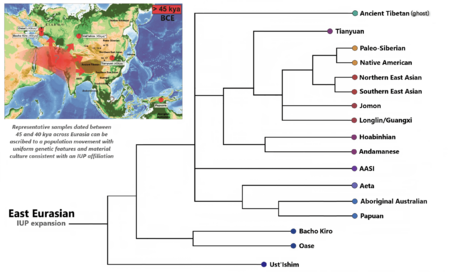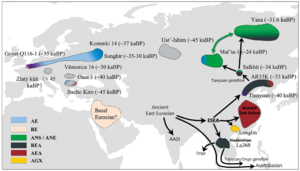Tianyuan man facts for kids
Quick facts for kids Tianyuan man |
|---|
Tianyuan man (simplified Chinese: 田园洞人; traditional Chinese: 田園洞人; pinyin: Tiányuándòng Rén) refers to the bones of one of the first modern people to live in East Asia. In 2007, scientists found 34 bone pieces from one person at the Tianyuan Cave. This cave is located near Beijing, China.
Tests show these bones are between 42,000 and 39,000 years old. This makes them some of the oldest modern human remains found in East Asia. Other very old bones of a similar age were found in the Niah Caves on the island of Borneo.
Contents
What Tianyuan Man Ate
Scientists don't know much about the tools or items Tianyuan man used. This is because no such things have been found at the site yet.
However, by studying the bones, scientists learned about his diet. He ate a lot of freshwater fish. This means he likely lived near rivers or lakes.
About Tianyuan Man's Body
How Old Was Tianyuan Man?
Tianyuan man was an early type of Homo sapiens, which is the scientific name for modern humans. His jaw bones were different from those of older human groups in Europe.
Based on how worn his teeth were, scientists think he was in his 40s or 50s when he died.
Tianyuan Man's Ancient DNA
In 2013, scientists studied Tianyuan man's DNA for the first time. They found that his DNA is similar to that of many people living in Asia and North America today. His DNA was already different from the DNA of people who became modern Europeans.
He belonged to a specific genetic group called mitochondrial DNA haplogroup B. He also belonged to a paternal genetic group called haplogroup K2b.
Later, a full study of his entire DNA confirmed his close link to modern East and Southeast Asians. However, he is not a direct ancestor of today's populations. Instead, he represents an early branch of the East and Southeast Asian family tree. This branch split off very early from other groups.
Tianyuan man was part of a big movement of people during the Initial Upper Paleolithic period, over 45,000 years ago. These people shared similar genes and ways of life. His family group is connected to other ancient human remains found in places like Bacho Kiro and Ust'-Ishim. It also shares links with the ancestors of modern people in Papua New Guinea.
Tianyuan man's genetic group, sometimes called the "ESEA" group, is thought to have come from the Ancient East Eurasians. They likely traveled along a southern route. This group then split into different branches, including the Tianyuan branch and the group that led to all modern East and Southeast Asians.
Some of Tianyuan man's DNA (about 32-50%) was also found in ancient people from Northern Eurasia. These groups also had DNA from early West Eurasians. For example, a 34,000-year-old person from Mongolia had about 83% of their DNA from a Tianyuan-like group.
Tianyuan man also has a special genetic link to an ancient person found in the Goyet Caves in Belgium. This person from Goyet shares more DNA with Tianyuan man than any other ancient person from West Eurasia. This suggests that the Goyet person received some of their DNA (14-23%) from an early East Eurasian group related to Tianyuan man.
The DNA of Tianyuan man is also very similar to a 33,000-year-old person found between the Amur region and modern Mongolia. This shows that people with Tianyuan-like DNA were spread widely across Northeast Asia during the Stone Age.
The "Deep Asian" DNA, like that of Tianyuan man or the Onge people, helped populate Southeast Asia. This happened after the first groups from Australia and New Guinea arrived. Later, other groups from mainland Southeast Asia and Southern China expanded into the region.
|




